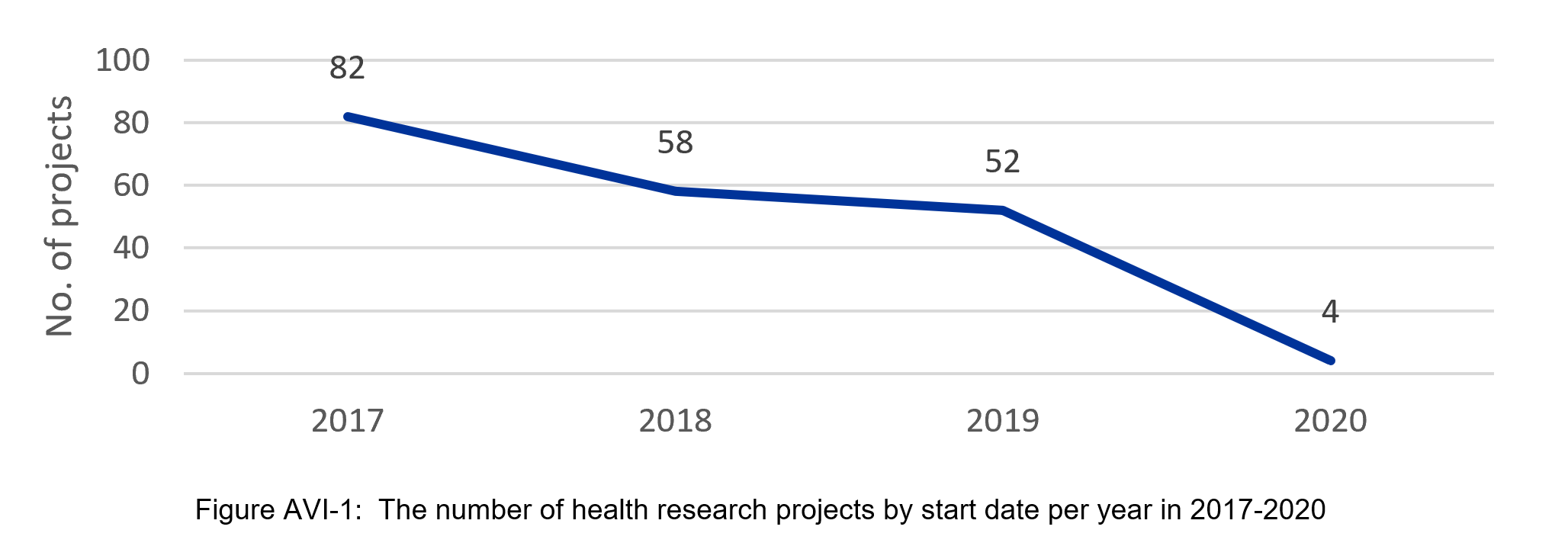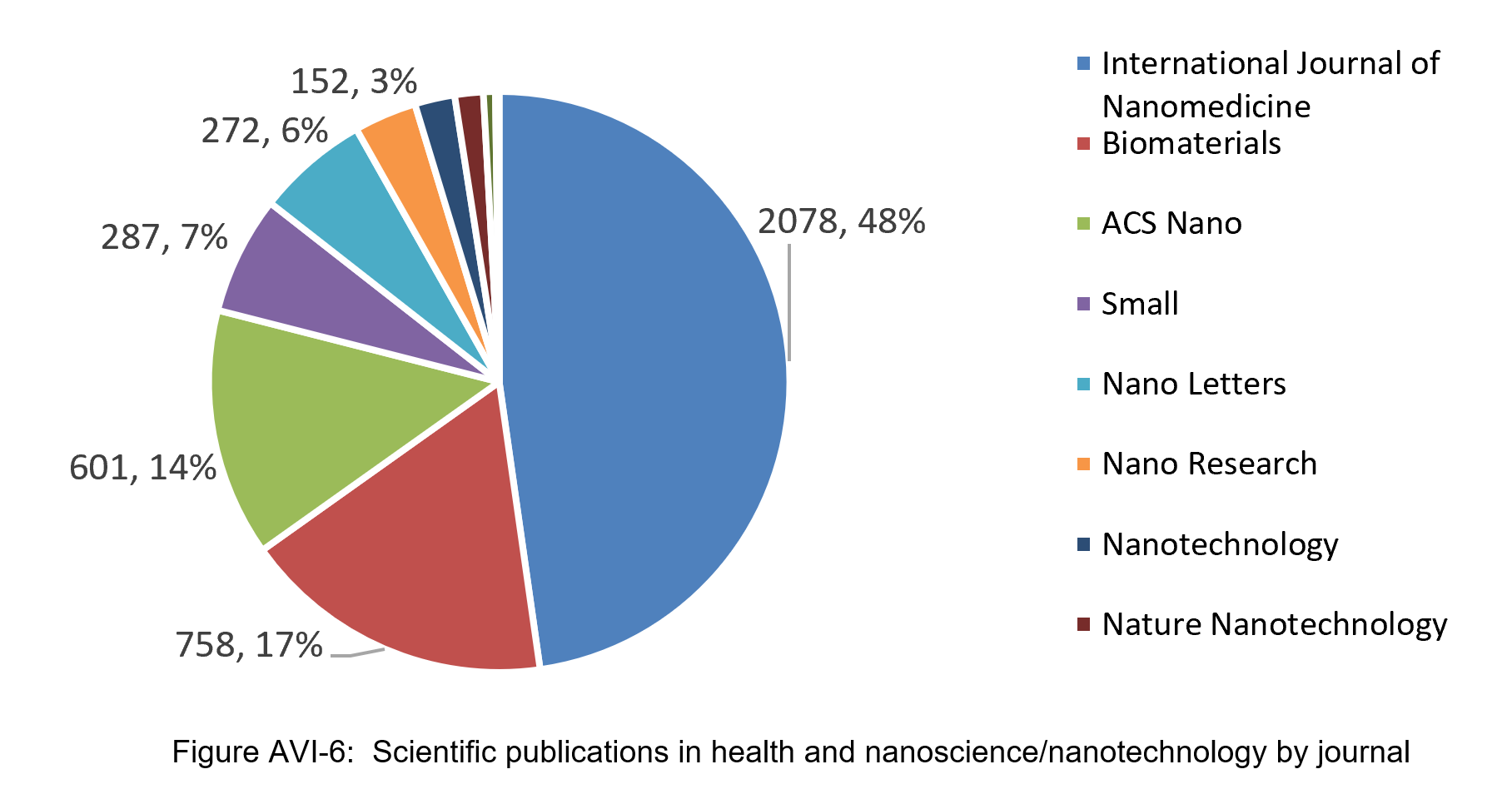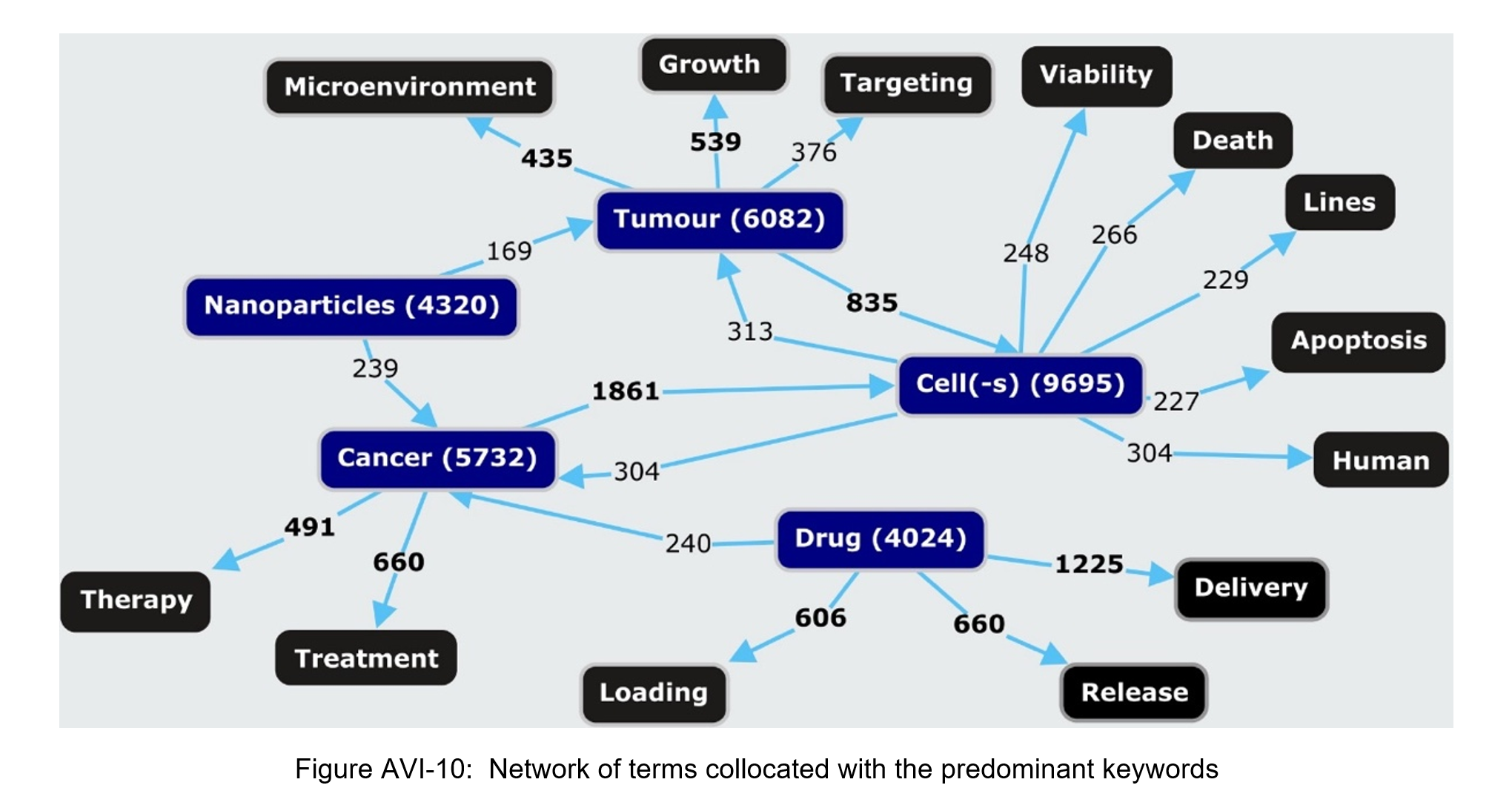R&D - EUON
Health
Research projects
In the period between 2017-2020, Horizon 2020 funded 196 projects in the field of medical and health sciences.1 Projects in medical and health sciences comprised 16% of all research projects in nanotechnology funded by the EU in 2017-2020.
Analysis of the start date of health projects shows that most of them received funding and started in 2017. H2020 covered the 2014-2020 period, so with 2017 as a mid-term of the programme, it is not surprising that the number of projects is high. The decreasing number of research projects towards the end of the funding period is explained by the fact that most research projects require several years to complete.

H2020 contained several high-level programmes/priorities/specific actions and their sub-programmes. H2020 contained several high-level programmes/priorities/specific actions and their sub-programmes. Three thematic and two horizontal high-level programmes funded nanotechnology research and innovation:
- Priority “Excellent science” (1) aimed to improve the excellence of the European research base and consolidate the European Research Area (ERA) to increase the global competitiveness of European research and innovation.
- Priority “Industrial leadership” (2) focused on boosting the development of the technologies and innovations that will underpin future businesses and help innovative European SMEs to grow into world-leading companies. This priority contained a sub-programme targeted at nanotechnologies.
- Priority “Societal challenges” (3) focused on the societal challenges that were identified in the Europe 2020 strategy and aimed to encourage sufficient research and innovation efforts necessary to cope with these challenges and achieve the EU strategic goals.
- Specific objective “Spreading excellence and widening participation” (4) was a horizontal objective of Horizon 2020 aimed at pooling research and innovation talents in Europe, nurturing and connecting pools of excellence to maximise and fully exploit Europe’s research and innovation potential.
- Specific objective “Science with and for society” (5) was a horizontal objective of Horizon 2020 aimed at strengthening the collaboration between science and society by engaging citizens in science and using the collective intelligence for solving research problems, promoting scientific careers, etc.
Each of the described high-level programmes contained the whole hierarchy of sub-programmes. Usually, one project received funding through a combination of programmes. Those combinations of (sub)programmes from 2017-2020 were filtered out. Figure AVI-2 gives an overview of programmes and subprogrammes that funded health research under Horizon 2020.

Between 2017-2020, Horizon 2020 health research projects were more focused on scientific excellence than industrial innovation. The largest portion of health projects received funding under the priority “Excellent science” and its subprogrammes: 1.3.2. Nurturing excellence by means of cross-border and cross-sector mobility (49 projects and 27 projects in combination with subprogramme 1.3.), 1.1. European Research Council (33 projects), and 1.3. Marie Skłodowska-Curie Actions (in combination with 1.3.2., 27 projects). These programmes are focused on building the capacity of individual researchers and their teams as well as encouraging collaboration between researchers.
Less projects were funded under the priority “Industrial leadership” that promoted nanotechnology innovation and commercialisation. In total forty-eight projects were funded under various combinations of the following subprogrammes: 2.1. Leadership in enabling and industrial technologies and 2.1.2. Nanotechnologies, 2.1.3. Advanced Materials, 2.1.5. Advanced manufacturing and processing and 2.3. Innovation in SMEs, including 2.3.1. Mainstreaming SME support, especially through a dedicated instrument. Twenty-three projects also focused on the third priority of Horizon 2020 – Societal challenges.
To understand the major topics of interest in health research, project titles were analysed with Voyant Tools. The analysis revealed several predominant terms – cell(-s) (33), cancer (20), disease(-s) – 20; treatment(-s) (17); delivery (15), therapy(-ies) (15), and drug (14).

The visibility of specific keywords shows that some projects are oriented towards treatment of diseases and especially cancer, as well as drug discovery and delivery for therapeutic purposes.

The manual inspection of the content of project titles shows that cancer and malignant tumour-related topics were visible in 26 projects (13%). However, 50 projects (26%) focused on the treatment of a wide range of other diseases and conditions: e.g., tissue engineering and/or regeneration (9 projects), diabetes (4 projects), inflammatory bowel disease (3 projects), neurodegenerative diseases (3 projects), eye diseases (3 projects) and many others (e.g., Parkinson’s disease, epilepsy, liver disease, kidney disease, chronic pain, trauma and injuries, etc.). Analysis revealed that 28 projects (14%) investigated the development and/or application of devices for medical diagnostics, treatment or monitoring as well as medical research (e.g., devices for automated egg cell inspection and sorting, miniaturised optically accessible bioreactor for drug discovery and biological research, next generation urinary catheters, easy-to-wear and comfortable compression stocking, etc.). Drug discovery and/or delivery was investigated in 14 projects (7%), which were often focused on other topics as well, such as treatment of certain diseases, medical devices, etc. (e.g., miniaturised optically accessible bioreactor for drug discovery, disruptive targeted drug delivery system, drug to treat glaucoma and other neurogenerative diseases, etc.).
Scientific publications
In the period between 2017-2020, 4,352 papers in medical and health sciences and nanotechnology/nanoscience were published in the forty journals of the first and second quartiles selected for this research. The number of papers from 2017-2020 steadily increased culminating in 2020 with 1,232 papers in the field of health and nanoscience/nanotechnology.

The publishing pattern of scientific publications between 2017-2020 shows an increase in research interest in nanotechnology applications in the health sector.
Most papers were published in eleven journals that belong to the first and second quartiles according to their citation data. However, the largest part of the research content was concentrated in three journals – International Journal of Nanomedicine, Biomaterials and ACS Nano.

Approximately half of all papers were published in the International Journal of Nanomedicine (48%, 2078 papers). Substantial amounts of paper were published in the journals Biomaterials (17%, 758 papers) and ACS Nano (14%, 601 paper). The International Journal of Nanomedicine (Q2, published by Dove Medical Press Ltd., New Zealand) is focused on the application of nanotechnology in medicine, covering such issues as diagnostics, therapeutics and drug delivery field. It highlights the importance of the clinical application of research and development for prevention and treatment of diseases. Biomaterials (Q1, published by Elsevier, UK) focuses on the clinical application of biomaterials (especially medical technology and regenerative medicine) and covers such themes as polymer synthesis and characterization, drug and gene vector design, the biology of the host response, immunology and toxicology and self-assembly at the nanoscale. ACS Nano (Q1, published by the American Chemical Society, USA) offers an interdisciplinary approach to nanotechnology through the prism of chemistry, biology, materials science, physics, and engineering. The scientific papers in the field of health were authored by 11,398 scholars from 80 countries. Most papers were authored by multiple researchers that in many cases represented international teams. Therefore, the study team analysed mentions of country in each author’s affiliation record. Figure 9 7 provides an overview of the ten most mentioned countries in the affiliation of authors.

Analysis of countries in affiliations of the authors revealed that most authors represented China (5279), the United States of America (1795), and South Korea (563). Analysis of researchers’ affiliation institutions showed the prevalence of Chinese research and higher education institutions in the list of top ten organisations quoted in authors’ data.

In the list of most mentioned institutions only one organization – Harvard University, represents the USA. Automated text analysis of paper titles and abstracts revealed five predominant terms: tumour(-s) (7,242), cancer (5732), cell(-s) (5,708), nanoparticle(-s) (5,281), drug(-s) (4,958).

The list of predominant keywords shows that most scientific papers focus on the application of nanoparticles for the treatment of cancer and tumours. Although the titles of some papers do not specify the nature of tumours, the abstracts often refer to cancer. Some papers are dedicated to specific malignant tumours – e.g., glioblastoma. Types of cancer often mentioned in the paper titles are breast cancer (185 mentions), lung cancer (46), pancreatic cancer (44), melanoma (43), prostate cancer (39), colorectal cancer (32), and glioblastoma (32). Among less mentioned – liver cancer, ovarian cancer, colon cancer, cervical cancer, gastric cancer and murine cancer. The focus of scientific papers on cancer was also found by the literature/progress reviews on the field of nanomedicine that applies nanotechnology for diagnosing, treating or preventing diseases.2 For instance, Germain et al.3 examined clinical trials in the USA in 2008-2020 and discovered that 65% of clinical trials related to cancer applications of nanoparticles. The analysis of scientific publications by the European Commission4 in 1996-2016 revealed that terms “nanomedicine” and “cancer” appeared together in over 50 scientific publications. In particular, the application of nanoparticles is related to developing drugs, where nanoparticles play an important role in the efficient delivery of drugs to the target site in human organism. In the research of scientific publications in nanomedicine in 2000-2019, Zhang et al.5 highlighted the same trend – high visibility of drug delivery research. According to Zhang et al.6 49% of publications in the analysed period focused on drug delivery which appears to be the largest research area in nanomedicine. The detailed analysis of the network of terms collocated to the most often mentioned keywords in the scientific publications shows that processes that happen in cancer and/or tumour cells are in the focus of most research papers. The terms “cancer” and “cell(-s)” co-occurred 1861 times, while the terms “tumour” and “cell(-s)” – 835 times. The second most common term collocation is “drug” and “delivery” – 1225 times.

The analysis of co-occurence of the terms “drug” and “delivery” shows that these papers are focused on the application of nanotechnology in drug delivery systems. According to the U.S. National Institute of Biomedical Imaging and Bioengineering (2016), “drug delivery systems are engineered technologies for the targeted delivery and/or controlled release of therapeutic agents”.7 Nanocarriers are used to transport drug substances to the designated site or organ in human body. Various nanocarriers are mentioned in the papers, including magnetic nanocarriers, liposomes, peptide-modified nanocarriers, lipid nanoparticles, gold nanoparticles and many others.
Scientific breakthroughs
A scientific breakthrough is a research publication that has a substantial impact on the further research of the issue addressed in such paper. The study uses the scientometric approach that develops and applies quantitative measures to analyse patterns in scholarly communication for identifying breakthrough publications. Scientific breakthroughs were identified by analysing the number of citations, the share of recent citations and the number of different research fields in the citation data of the paper. The research identified four health publications that met the criteria for scientific breakthroughs (see Table AVI-3). Remarkably, three publications related to COVID-19 issues, while only one – to cancer treatment. Seo et al.8 and Qiu et al.9 investigated the application of biosensors for the detection of COVID-19, while Konda et al.10 analysed the performance of fabric face masks against small particles.
| Table AVI-3: Scientific breakthroughs in the field of health | ||||
|---|---|---|---|---|
| Bibliographic data | Citations | Recents citations | Citing FORs | Altmetric score |
| Seo, G. et al. (2020). Rapid detection of COVID-19 causative virus (SARS-CoV-2) in human nasopharyngeal swab specimens using field-effect transistor-based biosensor. ACS nano, 14(4), 5135-5142. | 786 | 786 | 12 | 314 |
| Qiu, G. et al. (2020). Dual-functional plasmonic photothermal biosensors for highly accurate severe acute respiratory syndrome coronavirus 2 detection. ACS nano, 14(5), 5268-5277. | 512 | 512 | 12 | 520 |
| Konda, A. et al. (2020). Aerosol filtration efficiency of common fabrics used in respiratory cloth masks. ACS nano, 14(5), 6339-6347. | 510 | 510 | 17 | 7189 |
| Min, Y. et al. (2017). Antigen-capturing nanoparticles improve the abscopal effect and cancer immunotherapy. Nature nanotechnology, 12(9), 877-882. | 373 | 232 | 9 | 188 |
COVID-19 topics were not visible in the entire corpus of scientific papers published between 2017-2020 because the pandemics occurred in the last year of this period. However, three scientific breakthroughs related to COVID-19 were published in 2020.
Analysis of altmetric score provided by Dimensions.ai revealed that three publications on the COVID-19 topics received substantial attention from the publics and other innovation stakeholders. For instance, the research paper by Konda et al.11 received substantial coverage in news and social media (including blogs, Facebook, and Twitter). It was quoted in policy documents and in one patent and kept in Mendeley lists of references for more than a thousand times. This means a lot of attention from policymakers, peer scholars and the public as well as some impact on inventions. The study explored the performance of fabric face masks in terms of filtration of aerosol particulate sizes in the 10 nm to 10 μm range to understand their potential to prevent virus transmission. The paper by Konda et al.12 showed an exceptionally high impact on other research fields.

Figure AVI 11 shows that papers published in the seventeen fields of research cited Konda et al.13 Although two thirds of citations came from medical and health sciences, engineering and technology, other fields such as life, social sciences and humanities also quoted the paper in their publications.
1 Only the projects that listed “medical and health sciences” as the first subject category — which means that this is the main research field — were selected for analysis.
2 Quirós Pesudo, L., Balahur, A., Gottardo, S., Rasmussen, K., Wagner, G., Joann, G., & Bremer-Hoffmann, S. (2018). Mapping nanomedicine terminology in the regulatory landscape. Carried out by Joint Research Centre. Available at: https://data.europa.eu/doi/10.2760/753829
3 Germain, M., Caputo, F., Metcalfe, S., Tosi, G., Spring, K., Åslund, A. K., Pottier, A., Schiffelers, R., Ceccaldi, A., & Schmid, R. (2020). Delivering the power of nanomedicine to patients today. Journal of Controlled Release, 326, 164-171.
4 Quirós Pesudo, L., Balahur, A., Gottardo, S., Rasmussen, K., Wagner, G., Joann, G., & Bremer-Hoffmann, S. (2018). Mapping nanomedicine terminology in the regulatory landscape. Carried out by Joint Research Centre. Available at: https://data.europa.eu/doi/10.2760/753829
5 Zhang, C., Yan, L., Wang, X., Zhu, S., Chen, C., Gu, Z., & Zhao, Y. (2020). Progress, challenges, and future of nanomedicine. Nanotoday, 35, 101008.
6 Ibid.
7 National Institute of Biomedical Imaging and Bioengineering. (2016). Drug delivery systems. Available at: https://www.nibib.nih.gov/science-education/science-topics/drug-delivery-systems-getting-drugs-their-targets-controlled-manner
8 Seo, G. et al. (2020). Rapid detection of COVID-19 causative virus (SARS-CoV-2) in human nasopharyngeal swab specimens using field-effect transistor-based biosensor. ACS nano, 14(4), 5135-5142.
9 Qiu, G. et al. (2020). Dual-functional plasmonic photothermal biosensors for highly accurate severe acute respiratory syndrome coronavirus 2 detection. ACS nano, 14(5), 5268-5277.
10 Konda, A. et al. (2020). Aerosol filtration efficiency of common fabrics used in respiratory cloth masks. ACS nano, 14(5), 6339-6347.
11 Ibid.
12 Ibid.
13 European Patent Office. (2022). Cooperative Patent Classification, A: Preparations for medical, dental or toilet purposes. Available at: https://www.cooperativepatentclassification.org/sites/default/files/cpc/scheme/A/scheme-A61K.pdf


